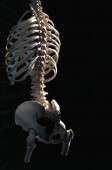Lumbar spine BMD ups Fx risk in women with discordant T-scores

(HealthDay)—Lumbar spine (LS) bone mineral density (BMD) increases fracture risk among women with lower LS T-score than femoral neck (FN) T-score, according to a study published online Aug. 4 in the Journal of Bone and Mineral Research.
Dunia Alarkawi, M.B.B.S., M.P.H., from St. Vincent's Hospital in Sydney, and colleagues examined the impact of LS BMD on fracture risk in individuals with lower LS T-score than FN T-score. Participants were enrolled from the Dubbo Osteoporosis Epidemiology Study and were aged older than 60 years.
The researchers found that 573 of 2,270 women and 131 of 1,373 men had lower LS than FN T-score by ≥0.6 standard deviation (SD). Each 1 SD lower LS T-score than FN T-score correlated with a significantly increased fracture risk in low LS women (hazard ratio, 1.30; 95 percent confidence interval, 1.11 to 1.45). For each 1 SD lower LS than FN T-score, there was a non-significant increase in fracture risk for low LS men (hazard ratio, 1.20; 95 percent confidence interval, 0.10 to 1.67). The absolute fracture risk was greater for low LS women versus other women, with the increased risk more pronounced for lower levels of FN T-score and in older age groups.
"This study demonstrates the significant contribution of lower LS BMD to fracture risk over and above FN BMD in women," the authors write.
The study was partially funded by grants from the pharmaceutical industry.
More information:
Abstract
Full Text (subscription or payment may be required)
Copyright © 2015 HealthDay. All rights reserved.















